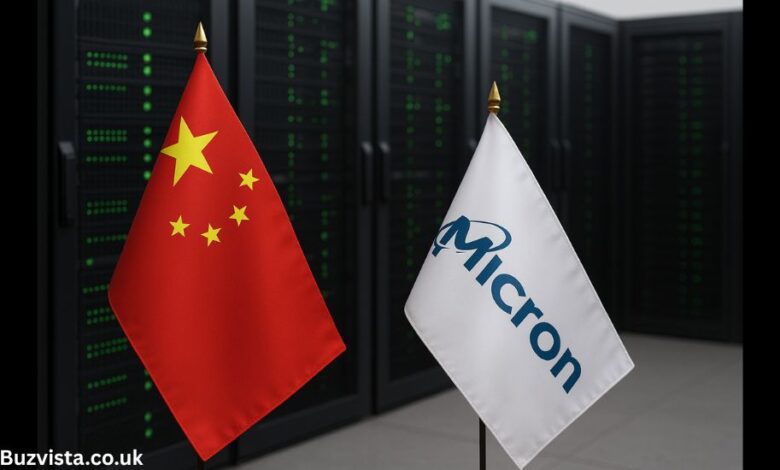Exclusive: Micron to Exit Server Chips Business in China After Ban, Sources Say

In one of the most consequential moves in the global semiconductor arena this decade, Micron Technology is preparing to withdraw from the server-memory and data-center chip market in mainland China, according to sources familiar with the company’s plans. The decision follows a series of regulatory and geopolitical headwinds that began with China’s 2023 ban on Micron products in “critical infrastructure” systems.
This withdrawal is not merely a corporate business adjustment—it symbolizes the widening fault line between the United States and China over technology supremacy. The decision marks a turning point for Micron, signaling that the world’s memory-chip industry can no longer operate purely on commercial logic. Politics and national security now sit squarely at the heart of global chipmaking.
The Background: China’s 2023 Ban and the Tech Divide
To understand Micron’s retreat, we must look back at 2023. That year, China’s cyberspace regulators launched a sweeping “security review” of Micron’s memory products, ultimately ruling that they posed significant network-security risks. The ruling barred Chinese companies operating in critical sectors—such as telecommunications, finance, transport, and government—from purchasing Micron chips.
The announcement sent shockwaves through the global semiconductor supply chain. It was widely interpreted as Beijing’s retaliatory response to Washington’s export controls on advanced chip-making tools and technology. In essence, Micron had become the first major U.S. chipmaker explicitly targeted by Chinese authorities under the banner of national security.
In practice, the decision restricted Micron’s access to one of its most important markets. Chinese data-center operators and server manufacturers began shifting procurement toward domestic alternatives, including local memory producers and South Korean giants. For Micron, whose Chinese market accounted for billions of dollars in annual revenue, the impact was immediate and severe.
Yet even after the ban, Micron continued to operate in China in limited capacities—supplying chips for consumer electronics, smartphones, and vehicles. The company hoped that the data-center segment might stabilize over time. However, the recovery never came.
Why Micron Is Exiting Now
Two years after the ban, Micron appears to have concluded that the costs and complexities of maintaining its server-memory business in China outweigh the potential benefits. The decision to withdraw from the market was not sudden—it reflects months of declining sales, persistent regulatory friction, and a re-evaluation of the company’s global priorities.
Several factors drove this choice:
- Persistent Market Contraction
Following the 2023 ban, most of Micron’s Chinese data-center clients either suspended or ended purchases. Even after extensive outreach and adaptation, the lost market share never returned. Without access to major Chinese server builders, the business had little room to grow. - Regulatory Uncertainty
The Chinese regulatory environment for foreign semiconductor firms remains unpredictable. For Micron, this created constant operational risk. Continuing to sell server chips could expose the company to sudden compliance crackdowns or new restrictions. - Strategic Refocus on High-Growth Markets
Globally, Micron’s growth now comes from sectors such as AI-optimized data centers, high-performance computing, and automotive electronics. These areas offer faster revenue expansion and higher margins—without the political friction that now accompanies Chinese data-center sales. - Reputation and Risk Management
Since 2023, Chinese authorities have labeled Micron’s products as security risks. Operating within that environment would require continuous defense of the company’s brand integrity. Exiting the contested market allows Micron to focus on innovation rather than political firefighting.
The withdrawal, therefore, represents not a failure of technology but a strategic decision to protect long-term stability.
What the Exit Covers—and What It Doesn’t
Micron’s departure is targeted rather than total. The company will discontinue supplying server-grade memory and storage chips to data-center customers inside mainland China, but it will continue selling to Chinese firms operating data centers outside China, such as global hardware manufacturers.
In addition, Micron will maintain its automotive and smartphone memory business in China, segments that remain unaffected by the 2023 ban. The company’s packaging and assembly operations in China will also continue running, as these are largely export-oriented and not subject to national-security reviews.
In short, Micron is not abandoning China—it is scaling back selectively, stepping away from politically sensitive domains while retaining viable commercial ones.
Economic and Market Implications
Financial Impact
Before the ban, China accounted for roughly one-eighth of Micron’s global revenue. Exiting a large market like that inevitably brings financial pain. However, the decline in sales began in 2023, meaning the worst of the impact has already been absorbed. The exit now formalizes a reality the company has been living with for two years.
Fortunately, global demand for high-end memory has surged since 2024, driven by the AI revolution, cloud expansion, and edge computing. Micron’s leading DRAM and NAND products are in heavy demand from hyperscale data-center operators in the U.S., Europe, and Southeast Asia. This global upturn helps offset losses from China.
Competitor Advantage
Micron’s retreat creates a vacuum that rivals will rush to fill. South Korean companies such as Samsung and SK Hynix, along with emerging Chinese memory makers, will likely capture a larger slice of China’s domestic data-center market. This shift could accelerate China’s push toward semiconductor self-sufficiency.
For Chinese companies, the departure of Micron offers both opportunity and pressure: opportunity to expand market share, and pressure to meet performance and reliability standards that Micron previously set.
Geopolitical Ripples
Micron’s exit illustrates how deeply intertwined global technology and geopolitics have become. What was once a business decision—where to sell chips—is now a question of national allegiance. The United States continues to tighten export restrictions on semiconductor equipment, while China doubles down on its drive for domestic alternatives. Each side views the other’s actions through a security lens.
In that environment, Micron’s decision reads less as a voluntary withdrawal and more as a forced realignment with the geopolitical realities of the 2020s.
China’s Strategic Rationale
China’s original 2023 ban was not a random or purely punitive act. It was a carefully calibrated move designed to serve multiple goals:
- National Security
The Chinese government considers information infrastructure—servers, cloud networks, and telecom backbones—vital to national stability. Using foreign-made memory components in those systems was deemed a vulnerability. - Industrial Policy
By excluding a U.S. leader like Micron, China created protected space for domestic memory-chip producers. These companies now receive preferential treatment, subsidies, and guaranteed demand, helping them climb the technological ladder faster. - Signaling Power
The ban sent a message: China can and will respond to Western export controls with targeted measures of its own. By striking a high-profile U.S. company, Beijing underscored that its tech-policy retaliation carries weight. - Selective Decoupling
Importantly, China did not ban Micron products across all sectors—only those tied to national security. This targeted approach allowed China to maintain economic pragmatism while asserting political control.
Strategic Implications for Micron and the Industry
The exit reshapes Micron’s global posture. Without a major data-center footprint in China, the company will intensify its focus on AI infrastructure, automotive electronics, and next-generation memory technologies such as HBM (High Bandwidth Memory). These areas are central to future computing demands and largely insulated from Chinese regulation.
At the same time, Micron’s global peers are learning a similar lesson: diversification is no longer just about revenue streams—it’s about political risk management. Semiconductor firms are re-engineering supply chains to minimize exposure to any single jurisdiction.
This shift also accelerates the regionalization of the chip industry. Whereas the last three decades were about globalization and efficiency, the next decade is about redundancy, resilience, and strategic autonomy. Every major region—China, the United States, Europe, and Japan—is investing heavily to ensure local chip capacity. Micron’s exit from China exemplifies this fragmentation.
Risks for Both Sides
For Micron
- Loss of Market Presence: Leaving China’s data-center market may hinder long-term growth and limit visibility in Asia’s fastest-expanding tech ecosystem.
- Brand Erosion: The label of being a “security risk” could linger, complicating relationships in other markets.
- Operational Shifts: Reassigning staff and resources previously dedicated to China requires careful management to avoid disruption.
For China
- Short-Term Technological Gap: Domestic memory makers may take years to match Micron’s product reliability and yields.
- Potential Global Backlash: Targeting foreign firms might discourage other multinationals from investing in China.
- Economic Efficiency Loss: Replacing proven technology with nascent local alternatives could temporarily raise costs and reduce performance in certain sectors.
Both parties, therefore, incur costs in this standoff. But both also see strategic value in accepting them—Micron, for stability and global focus; China, for sovereignty and self-reliance.
A Symbol of the New Tech Cold War
Micron’s withdrawal is more than a corporate restructuring—it’s a symptom of a broader geopolitical transformation. The semiconductor industry now sits at the intersection of economic competition and national security rivalry. Memory chips, once seen as generic components, have become strategic assets.
The era of seamless global tech integration is ending. Instead, two ecosystems are emerging: one led by the United States and its allies, the other by China and its partners. Each is building its own supply chains, standards, and spheres of influence. Micron’s exit from China is one of the clearest markers of this bifurcation.
The implications reach far beyond memory chips. As both powers fortify their technological borders, smaller nations and corporations face difficult choices—align, balance, or diversify? The outcome will shape the geography of innovation for decades.
What Happens Next
In the coming years, several trends will define the post-Micron era in China:
- Rapid Domestic Substitution: Chinese memory producers will expand aggressively, aiming to capture the market share vacated by Micron.
- International Realignment: Micron will strengthen alliances with non-Chinese OEMs and cloud providers to secure long-term contracts.
- Policy Escalation: Additional restrictions from both governments may follow, further segmenting the global chip ecosystem.
- Innovation Race: Expect heightened competition in advanced packaging, energy-efficient memory, and AI-optimized architectures.
For the global semiconductor industry, Micron’s exit marks another step toward a divided yet dynamically evolving world order.
Conclusion
Micron’s decision to leave China’s server-chip business underscores how technology, economics, and politics have become inseparable. Once a cornerstone of globalization, the semiconductor industry is now a proxy battlefield for strategic influence. Micron’s withdrawal may protect its business in the short term, but it also reflects a sobering truth: no company, however advanced, can remain apolitical in an age of technological nationalism.
As the semiconductor map redraws itself, companies will be judged not only by their innovation but also by their geopolitical agility. The story of Micron’s exit is thus both a cautionary tale and a glimpse into the future—where power, chips, and politics converge.
Article published by Newsta



